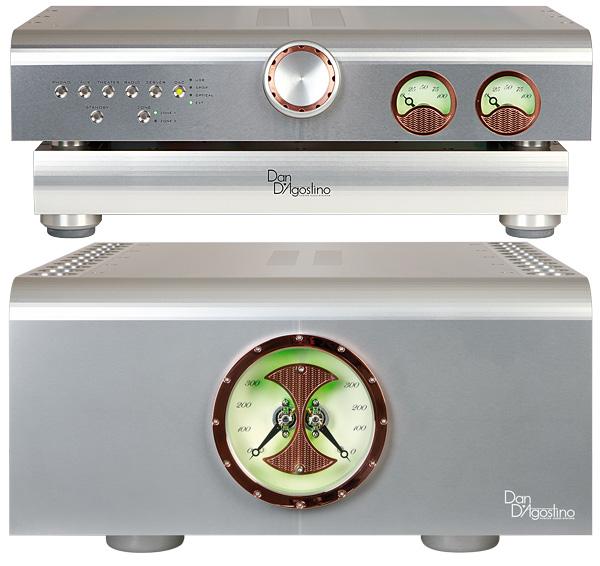D'Agostino Progression Preamplifier/Stereo pre/power amplifier

 Inspired by the ‘Momentum’ circuit and industrial design that put D’Agostino Master Audio Systems on the map, its Progression series could make the biggest impact yet
Inspired by the ‘Momentum’ circuit and industrial design that put D’Agostino Master Audio Systems on the map, its Progression series could make the biggest impact yet
The Progression Stereo amplifier is built around a dual-wound 1400VA toroidal transformer coupled to 400,000µF of power supply storage capacitance that feeds no fewer than 48 power transistors – 24 per channel. On paper this is said to generate 300W/8ohm, doubling into 4ohm [see PM's Lab Report]. And it’s yours for roughly half the price of a pair of the company’s Progression Monoblocks [HFN Jun ’17].
Unsurprisingly, such monumental output power generates a good deal of heat that requires dissipation. As in the Momentum models, CEO Dan D’Agostino’s solution is a series of venturi-style circular ‘chimneys’ found either side of the amp. These are milled from a single 22kg aluminium slab, the material being more affordable than the rose copper used for the Momentum series, so helping to keep down costs.
Going Green
The Swiss watch-inspired green illuminated power meter that now adorns all the company’s preamps and amplifiers is retained, serving not only to differentiate the components from the competition – as the Krell blue LEDs once did for Dan’s first company – but to echo the brand’s green credentials. He believes that ‘the audio industry should do its part to conserve energy and help preserve our environment’. Remember those energy-hungry, fan-cooled Krell Class A amplifiers of yesteryear? Today’s Progression amplifiers are said to consume less than one watt of power at idle, though PM’s lab tests indicated otherwise of course!

Dan has remained faithful to the fully balanced operation that was core to his Krell amplifier designs, aided in this new era by a ‘Super Rail’ that he likens to a turbo in a car engine, ‘boosting’ the output of the Progression Stereo by utilising higher voltage in the prior gain stages.
From a distance you cannot tell the Progression Mono and Stereo power amplifiers apart. They are equally imposing with the same 457x190x508mm (whd) dimensions and, at 57kg, they are equally back-breaking.
Only their power outputs differ, the Mono said to offer 500W/8ohm courtesy of the ‘two’ internal amplifiers operating as one bridged monoblock. Of course, the Progression Stereo power meter sports two swing arm needles in order to cover the output of both channels. And, of course, there are two balanced XLR inputs and two sets of gold-plated 4mm speaker binding posts.
Nothing else separates them at birth. They share the same clean fascia, dominated by that copper-green meter and have a power button hidden at the front underside edge. On the rear panel of both amps can be found a 12V on/off trigger connection, a toggle to set the meter brightness, a main breaker switch and the AC power connector.
I find the Progression amplifiers more appealing visually – and acoustically – than the Momentum models, and might be the only one who dares say it (though I have not listened to the Momentum M400 monoblock yet, reviewed in HFN Oct ’16). Which either makes this Progression Stereo a high-end ‘bargain’, or I risk making a fool of myself. To my mind they are just the right size and look even more purposeful – or should that be macho?

While we are on the subject of styling, the Momentum Preamp’s ‘watch’ necessarily protrudes because it includes a peripheral ring that spins into action [HFN Nov ’13]. But to some eyes this might not integrate so well with the amp’s overall cosmetics – looking like an add-on – while those rose copper heatsinks might also strike as a tad too feminine for our typically testosterone-driven audiophile tastes.
The Great Debate
The Progression Preamp was a tougher assignment for designer Dan. It’s not easy to challenge the Momentum Preamp – a work of art that’s hard to beat at any price. Personally, I love the design so much I could settle for the identical-looking Integrated [HFN Dec ’14] and forget all about the Momentum/Progression debate. Or else, go for the Momentum Preamp/Progression Stereo as an alternative to the Progression Preamp/Mono power amps. The price for both combinations is very similar, at around £72k.
For 50% of the price of the Momentum Preamp, the Progression Preamp yields 90% of the performance and far more than a mere sniff of the former’s beauty. What’s more, the Progression Preamp is the first of the company’s offerings to feature an optional DAC module that will set you back another £5000. The preamp also includes a Bluetooth remote handset that does not require line-of-sight to operate.
The Progression Preamp also features two multi-function meters (one per channel) that indicate signal level by default and gain and balance settings by selection. They also indicate inverted polarity, turning from green to red when you press the Polarity button on the remote; Mute, by alternating between green and white; or ‘Dark Mode’ by blanking out after 15 seconds.
The centrally placed volume knob, much more discreet than the Momentum’s, controls a precision-stepped attenuator that emits small clicks as you change the settings. A gain adjustment of +9dB or +15dB is also available, the latter to be used with low-gain power amplifiers. To the left of the front panel you can find the Standby, Zone, Analogue and Digital Source buttons. The latter’s LED indicators will only light if the DAC module is installed.























































